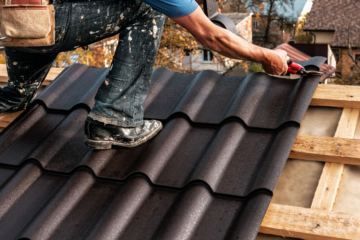
Which Roofing Materials are Sustainable?
In the past several years, increasing focus and attention have been given to the waste contribution and sustainability of building products. More than 10 million tons of asphalt shingles find their way yearly into landfills; this statistic alone demonstrates how roofing materials contribute to the ongoing issues of waste and environmental impact.
There are several different types of roofing materials that do not contribute as heavily to a home’s waste footprint. Some options are both sustainable and aesthetically pleasing!
Metal Roofing
Metal roofing fits the profile of a sustainable roofing material, not because of its biodegradable properties but because it lasts for decades and can require less energy to manufacture than other materials. Because metal systems last five to eight decades (depending on the variety of metal and method of installation), this roofing material outranks other less-sustainable and commonly used cladding, such as asphalt shingles.
Slate Roofing
Slate tile has been employed as a roofing material almost since the dawn of time and is recognized the world over for its durability and water- and fire-resisting properties. Slate roofs installed correctly can last a full century with minimal upkeep or attention! And while slate doesn’t break down easily, it far outlasts the average shingle roof that must be replaced every 20 years.
Homeowners looking for a sustainable roofing option should consider this material—a naturally occurring metamorphic rock that enjoys subtle differences in composition and appearance depending on where it is quarried.
Clay Tile Roofing
Because clay tile lasts such a long time, particularly if maintained well, it joins metal and slate in offering a great sustainable roofing solution.
Clay-tile roofs are robust, weathering wind, snow, hail, fire, mold, and salt air with ease. They can last as long as slate roofs–up to a century–while asphalt shingle roofs are long forgotten after a couple of decades. Clay’s ability to absorb and retain color allows it to be highly customizable, and tiles can be shaped into different kinds of configurations.
Thatch Roofing
Thatch roofing has a shorter life cycle than slate or clay tile roofing—about 15-20 years—however, it is recognized globally for its renewable, biodegradable, and sustainable credentials. It is most often made of water reed, long straw, or combed wheat reed.
Thatch roofing can be used on residential or commercial buildings and gives them an old-world feel and look. When installed correctly, thatch roofs are charming, extremely durable, and provide natural insulation, reducing the need to install additional insulating materials.
Thatch itself is a sustainable resource, easy to grow and harvest. Communities that grow thatch roofing materials benefit from the additional income. When installed, thatch roofing settles and forms a unique shape to the home; it does not form harsh lines like shingles or tile, creating natural customization.
Interested in sustainable roofing materials for your home or business? Contact the roofers with listings in this directory.










